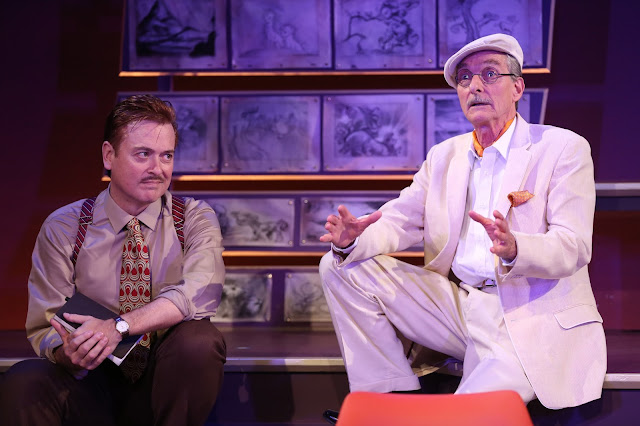“The Magic Touch”

 During the 1930s, animator Walt Disney had established himself as one of Hollywood’s best-known geniuses, having introduced the world to a galaxy of beloved characters, like Mickey Mouse and Donald Duck. In 1937, his Snow White and The Seven Dwarfs, the first full-length animated film, opened to worldwide acclaim, and his head was abuzz with countless new ideas for expanding the range of animated subjects. One was Fantasia (1940), intended to provide an aural and visual concert in which serious musical compositions were brought to vivid life by Disney’s team of brilliant collaborators.
During the 1930s, animator Walt Disney had established himself as one of Hollywood’s best-known geniuses, having introduced the world to a galaxy of beloved characters, like Mickey Mouse and Donald Duck. In 1937, his Snow White and The Seven Dwarfs, the first full-length animated film, opened to worldwide acclaim, and his head was abuzz with countless new ideas for expanding the range of animated subjects. One was Fantasia (1940), intended to provide an aural and visual concert in which serious musical compositions were brought to vivid life by Disney’s team of brilliant collaborators.  |
| Mark Shanahan, Stephen D'Ambrose. Photo: Carol Rosegg. |
 |
| Mark Shanahan, Stephen D'Ambrose. Photo: Carol Rosegg. |
It’s produced by the Penguin Rep Theatre, which staged it in Stony Point, NY, in 2015, where it was directed, as here, by Joe Brancato, with the same two actors. Its original two acts have been trimmed to one, running a tidy 90 minutes.
Like all such reimagined discussions where no transcript survives (like the recent Elvis and Nixon film about an actual meeting between the pop star and the POTUS), it takes considerable liberty with the facts but still manages to create a viable image of the personalities involved, their individual histories, and how they might have interacted.
It also visualizes two additional meetings that never occurred: one in 1941 and the other a fantasy set in the afterlife following the men’s deaths (Disney in 1966, Stravinsky in 1971). Disney is shown as a friendly, all-American guy representing the hopeful optimism of the American dream, believing anything is possible if you set your mind to it, convinced that he personally has “the magic touch,” and determined to create an art form that everyone will adore and thus prove commercially successful. Stravinsky, on the other hand, is presented as an arrogant, snobbish, sanctimonious elitist, so concerned with the integrity of his vision that he considers it sacrilege to betray it for financial gain.
Yet, for all his bonhomie, Disney is just as persistent in clinging to his ideals as the more overtly intransigent musician. What makes the play and its performances absorbing is the clash of these titanic temperaments, with Disney’s polite, reasonable, and accessible personality being put to the test in the face of the volatile Stravinsky (irked by Disney’s calling him “Iggy”), who’s vain, brash, and downright insulting when opining on Disney’s art, which he dismisses as mere “cartoons”
Perhaps the greatest liberty is the depiction of Stravinsky’s nastiness during the 1939 meeting; the play shows him ruthlessly denigrating what he believed Disney had done to his composition, musically and story-wise, by using it to support Fantasia’s famous dinosaur scene. He was particularly upset that his own storyline for “The Rites of Spring” was ignored in favor of something he felt was worthless and was convinced would be a box office flop. (It actually was until later releases made it film history’s 22nd biggest moneymaker.) The facts bear out the contention that it was only in later years that he turned against Disney and the film (which he famously called “unresisting imbecility”) and that his meeting was actually quite cordial.
Stroppel manages to keep the dialogue hopping as Disney and Stravinsky go through the throes of their artistic rites, while introducing a healthy dose of historical background material that allows the men to continue sparring, even over subjects like moral responsibility. We learn enough about their personal and professional affairs to keep us informed and interested, including Disney’s supposed pro-Nazi leanings (which he strongly denies) and the business problems he encountered with the onset of World War II.
We also watch the high-minded Stravinsky enjoying the fruits of success to which Fantasia contributed and seeking to squeeze his celebrity for more revenue; the change from his fur-coated, formal attire in 1939 to his Hollywoodish white slacks, cap, and jacket a couple of years later adds a delightfully satirical touch.
 |
| Mark Shanahan, Stephen D'Ambrose. Photo: Carol Rosegg. |
Patricia E. Doherty does a fine job evoking the kind of clothes these gentlemen would have worn, Christina Watanabe’s lighting includes some notable effects, William Neal’s sound design makes a fine contribution, and James M. Fenton’s set of platforms surrounded by numerous illustrations used in researching Fantasia is just right.
Pulling it all together are the actors. Mark Shanahan offers a warm, friendly man whose self-confidence eventually takes a body blow, while Stephen D’Ambrose’s mildly accented, bespectacled Stravinsky is perfectly proud, distinguished, and darkly Russian but ready with a perfectly timed zinger when the moment arrives.
 |
| Mark Shanahan, Stephen D'Ambrose. Photo: Carol Rosegg. |
Whether you’re a Disney or Stravinsky fan, or, hopefully, both, you should find Small World: A Fantasia a fascinating backstage confrontation between two of the greatest artists of the last century. And, with the magic of YouTube, you can even get a look at the revolutionary Fantasia and find out what all the fuss was about. As its name suggests, its pretty fantastic.
OTHER VIEWPOINTS:
59E59 Theaters/Theater B
59 E. 59 St., NYC
Through October 7
